Each state has designated a state bird as its symbol. Here’s some information about the birds which have been chosen to represent each state.
State bird of Alabama: Northern Flicker or Yellowhammer
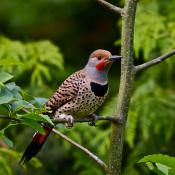
The northern flicker is a medium-sized bird of the woodpecker family. The flicker is the only woodpecker in North American that commonly finds food on the ground. It often forages for ants and beetle larvae on the ground.
State bird of Alaska: Willow Ptarmigan
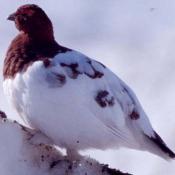
Adopted by the Territorial Legislature of Alaska in 1955. It is a small (15–17 in or 380–430 mm) Arctic grouse that lives among willows and on open tundra and muskeg. In the summer the birds are largely brown, with dappled plumage, but in the winter they are white with some black feathers in their tails. Most males are monogamous, guarding both nest and mate, helping with feeding and taking over completely if the female dies.
State bird of Arizona: Cactus Wren
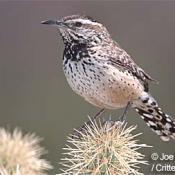
The cactus wren grows seven to eight inches long and likes to build nests in the protection of thorny desert plants like the arms of the giant saguaro cactus. The cactus wren forms permanent pair bonds, and the pairs defend a territory where they live all through the year.
In residential areas, cactus wrens are notorious for getting into mischief. Being curious birds, it is not uncommon for them to be found flying about out-of-place in automobiles or homes where a window has been left open.
State Bird of Arkansas: Mockingbird
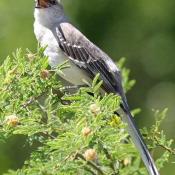
The mockingbird can imitate many sounds, including the chirps of some 35 different bird species. And the chatty flier can learn over 200 different songs in its lifetime. Northern mockingbirds are very smart animals. They are able to identify humans, especially those that tried to destroy their nests. Northern mockingbirds mate for a lifetime. Male and female build nest together and produce 2 to 4 broods per season. State bird of Arkansas, Florida, Mississippi, Tennessee, Texas
State Bird of California: California Valley Quail
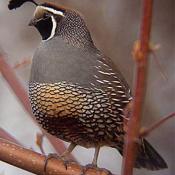
There are six native species of quail in the U.S. – bobwhite, California, mountain, Gambel’s, scaled , and Mearns quail (also called Montezuma quail). Gambel’s have a red top, California Valley quail have a blue/black top. They are offshoots of the same branch, cousins if you will.
The California quail is a highly sociable bird that often gathers in small flocks known as “coveys”. One of their daily communal activities is a dust bath. A group of quail will select an area where the ground has been newly turned or is soft, and using their underbellies, will burrow downward into the soil some one to two inches. They then wriggle about in the indentations they have created, flapping their wings and ruffling their feathers, causing dust to rise in the air. They seem to prefer sunny places in which to create these dust baths.
State Bird of Colorado: Lark Bunting .
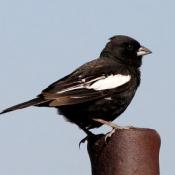
The lark bunting is a medium-sized American sparrow native to central and western North America.
Lark Buntings have interesting domestic arrangements. Pairs often nest close to one another in a loose “colony,” much as Dickcissels do. Most are monogamous, but some males breed with multiple partners (a mating system known as polygyny). In other areas, when males outnumber females, unmated males seem to serve as “nest helpers,” bringing food to young at the nest.
Sexual selection in lark buntings is particularly interesting, as female mate choice is radically different from year to year. In different years, females show preference based on males’ black coloring, size of wing patch, size of beak, as well as other characteristics.
State Bird of Connecticut: Robin
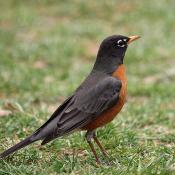
The robin is considered a symbol of spring, often the first migratory bird to return north. There is a Quebec superstition that whoever sees the first robin of spring will have good luck. American robins have exceptionally keen eyesight that allows them to see the tiny disturbances in the soil that indicate where worms are moving. This is how robins find worms, though they also use their senses of hearing and touch as part of their hunting as well. State bird of Connecticut, Michigan, Wisconsin
State Bird of Delaware: Blue Hen Chicken
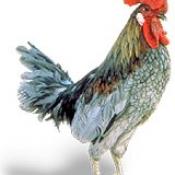
During the Revolutionary War, the men of Captain Jonathan Caldwell’s company, recruited in Kent County, took with them game chickens that were said to be of the brood of a famous Blue Hen and were noted for their fighting ability. When not fighting the enemy, the officers and men amused themselves by pitting their Blue Hen chickens in cockfights. The fame of these cockfights spread throughout the army and when in battle, the Delaware men fought so valiantly that they were compared to these fighting cocks.
The Delaware Blue Hen is a blue strain of American gamecock. It was adopted on April 14, 1939, as the state bird of Delaware. It is one of three U.S. state birds that is not a species native to the United States.
State Bird of Florida: Mockingbird

The mockingbird can imitate many sounds, including the chirps of some 35 different bird species. And the chatty flier can learn over 200 different songs in its lifetime. Northern mockingbirds are very smart animals. They are able to identify humans, especially those that tried to destroy their nests. Northern mockingbirds mate for a lifetime. Male and female build nest together and produce 2 to 4 broods per season. State bird of Arkansas, Florida, Mississippi, Tennessee, Texas
State Bird of Georgia: Brown Thrasher
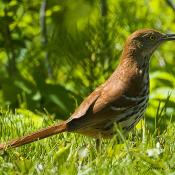
Same family as the mockingbird. Has over 1000 song types and the largest song repertoire of birds. Brown thrashers are generally inconspicuous but territorial birds, especially when defending their nests, and will attack species as large as humans.
State Bird of Hawaii: Hawaiin Goose or Nene
>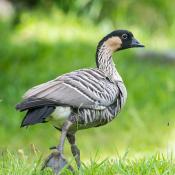
The nene is the world’s rarest goose. It is believed that it was once common, with approximately 25,000 Hawaiian geese living in Hawaii when Captain James Cook arrived in 1778. Hunting and introduced predators, such as small Asian mongooses, pigs, and cats, reduced the population to 30 birds by 1952. The species breeds well in captivity, and has been successfully re-introduced. In 2004, it was estimated that there were 800 birds in the wild, as well as 1,000 in wildfowl collections and zoos.
The nene is a herbivore that will either graze or browse, depending on the availability of vegetation. Food items include the leaves, seeds, fruit, and flowers of grasses and shrubs.
State bird of Idaho: Mountain Bluebird
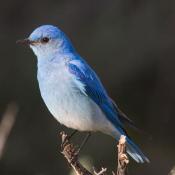
The different species of bluebirds are not very friendly with each other and even try to exclude the other species from their territories. This is especially true between Mountain Bluebirds and Western Bluebirds since they compete for the same nesting sites. Only the female bluebird builds the nest. The male sometimes acts as if he is helping, but he either brings no nest material or he drops it on the way. Many Native Americans in the southwest see the mountain bluebird as a sacred symbol because of its azure-colored feathers. The Navajo regard it as the herald of the rising sun, the image of a god. State bird of Idaho and Nevada.
State bird of Illinois: Cardinal
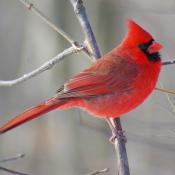
Unlike many other songbirds in North America, both the male and female cardinals can sing. Usually, only a male songbird is capable of singing. When a female cardinal sings from the nest, it usually means she’s telling the male she needs more food. Cardinals mate for life. A group of cardinals has many collective nouns, including a “college”, “conclave”, “deck”, “radiance”, and “Vatican” of cardinals.
The cardinal is the mascot of prominent sports teams and schools, including the St. Louis Cardinals (baseball) and Arizona Cardinals (football); it is the state bird of seven states, more than any other bird: Illinois, Indiana, Kentucky, North Carolina, Ohio, Virginia, West Virginia
State bird of Indiana: Cardinal

Unlike many other songbirds in North America, both the male and female cardinals can sing. Usually, only a male songbird is capable of singing. When a female cardinal sings from the nest, it usually means she’s telling the male she needs more food. Cardinals mate for life. A group of cardinals has many collective nouns, including a “college”, “conclave”, “deck”, “radiance”, and “Vatican” of cardinals.
The cardinal is the mascot of prominent sports teams and schools, including the St. Louis Cardinals (baseball) and Arizona Cardinals (football); it is the state bird of seven states, more than any other bird: Illinois, Indiana, Kentucky, North Carolina, Ohio, Virginia, West Virginia
State Bird of Iowa: Willow Goldfinch or American Goldfinch
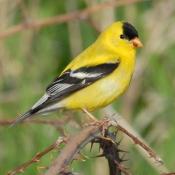
These are active and acrobatic little finches that cling to weeds and seed socks, and sometimes mill about in large numbers at feeders or on the ground beneath them. Goldfinches fly with a bouncy, undulating pattern and often call in flight, drawing attention to themselves. The American goldfinch is gregarious during the non-breeding season, when it is often found in large flocks, usually with other finches. The social hierarchy, measured by how many aggressive encounters are won by each individual, tends towards the male being dominant in the non-breeding season. During the breeding season, this finch lives in loose colonies. While the nest is being constructed, the male will act aggressively toward other males who intrude into his territory, driving them away, and the female reacts in the same way toward other females. This aggressiveness subsides once the eggs have been laid. State bird of Washington, Iowa, and New Jersey.
State Bird of Kansas: Western Meadowlark
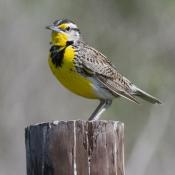
The western meadowlark is a member of the blackbird family. A male usually has two mates at the same time. The females do all the incubation and brooding, and most of the feeding of the young.
The male meadow lark uses visual display behaviors to attract a mate. When he finds a female that he wants to mate with, he points his bill in the air, puffs out his yellow throat and flaps his wings above his head. If that doesn’t get the female’s attention, he hops up and down. The western meadowlark builds its nest on the ground. The female finds a depression in the ground and shapes it by digging in the dirt with her bill. She lines the depression with soft grass and makes a roof by pulling grass and plants over the depression. She then weaves in grass to make a waterproof dome, leaving enough space for an opening. The female lays between three and seven eggs. It takes about 12 days for the eggs to hatch. The meadowlark usually has two broods a year. The male protects the nest by noisily chasing intruders away.
A male’s home range is usually about six or seven acres. If another male invades his territory, he may get into a fight with the intruder. Fighting meadowlarks lock their feet together and peck at each other with their beaks. State bird of Kansas, Oregon, Nebraska, Wyoming, North Dakota, and Montana
State bird of Kentucky: Cardinal

Unlike many other songbirds in North America, both the male and female cardinals can sing. Usually, only a male songbird is capable of singing. When a female cardinal sings from the nest, it usually means she’s telling the male she needs more food. Cardinals mate for life. A group of cardinals has many collective nouns, including a “college”, “conclave”, “deck”, “radiance”, and “Vatican” of cardinals.
The cardinal is the mascot of prominent sports teams and schools, including the St. Louis Cardinals (baseball) and Arizona Cardinals (football); it is the state bird of seven states, more than any other bird: Illinois, Indiana, Kentucky, North Carolina, Ohio, Virginia, West Virginia
State bird of Louisiana: Brown Pelican
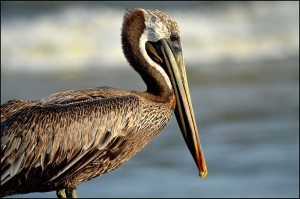
Brown Pelicans make their spectacular dives into the water from as high as 65 feet. If humans dove into the water at such a height over and over, we’d probably hurt ourselves. But pelicans have adapted to protect themselves. They have special air sacs beneath their skin that they inflate just before impact to protect internal organs. And as they dive, they rotate to the left, to avoid injuring their trachea and esophagus, which run along the right side of their neck.
There’s that poem by Dixon Lanier Merritt:
Oh, a wondrous bird is the pelican,
His bill can hold more than his belican,
He can take in his beak,
Food enough for a week,
But I’m damned if I see how the helican.
See Audubon.org
State Bird of Maine: Black-capped Chickadee
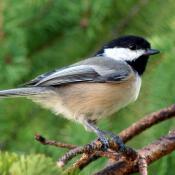
The chickadee makes at least 15 different calls to communicate with its flock-mates and offspring. The best known is the chickadee-dee-dee that gives the bird its name. The more “dee” sounds, the greater the danger. One chickadee has been observed to call with 23 “dee” sounds in the presence of a predator owl. Chickadees live in small groups and establish a dominance hierarchy, or “pecking order.” Each bird is known to the other according to rank which is set by its degree of aggressiveness. Accordingly, all the birds in the flock are subordinate to the most aggressive bird; and the lowest ranking bird is subordinate to all the others. When breeding season begins, the tiny brains of chickadees and other songbirds enlarge to enable the birds to create more sounds.
It is the state bird of both Maine and Massachusetts in the United States, and the provincial bird of New Brunswick in Canada.
State Bird of Maryland: Baltimore Oriole
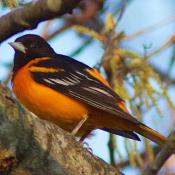
It received its name from the resemblance of the male’s colors (black and bright orange ) to those on the coat-of-arms of Lord Baltimore. A group of orioles is called a “split” or “pitch. Many fruit growers think of orioles as pests, because, with their love of sweet treats, they can wipe out crops. Five fruits you’ll often see them munching are raspberries, crabapples, grapes, mulberries, and cherries.
The Baltimore oriole is the state bird of Maryland and the inspiration for the Baltimore Orioles baseball team.
State Bird of Massachusetts: Black-capped Chickadee

The chickadee makes at least 15 different calls to communicate with its flock-mates and offspring. The best known is the chickadee-dee-dee that gives the bird its name. The more “dee” sounds, the greater the danger. One chickadee has been observed to call with 23 “dee” sounds in the presence of a predator owl. Chickadees live in small groups and establish a dominance hierarchy, or “pecking order.” Each bird is known to the other according to rank which is set by its degree of aggressiveness. Accordingly, all the birds in the flock are subordinate to the most aggressive bird; and the lowest ranking bird is subordinate to all the others. When breeding season begins, the tiny brains of chickadees and other songbirds enlarge to enable the birds to create more sounds.
It is the state bird of both Maine and Massachusetts in the United States, and the provincial bird of New Brunswick in Canada.
State bird of Michigan: Robin

The robin is considered a symbol of spring, often the first migratory bird to return north. There is a Quebec superstition that whoever sees the first robin of spring will have good luck. American robins have exceptionally keen eyesight that allows them to see the tiny disturbances in the soil that indicate where worms are moving. This is how robins find worms, though they also use their senses of hearing and touch as part of their hunting as well. State bird of Connecticut, Michigan, Wisconsin
State bird of Minnesota: Common Loon
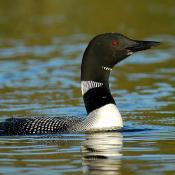
The common loon is the provincial bird of Ontario, and it appears on Canadian currency, including the one-dollar “loonie” coin and a previous series of $20 bills. In 1961, it was designated the state bird of Minnesota, and appears on the Minnesota State Quarter. The common loon is an expert fisher, catching its prey underwater by diving as deep as 60 m (200 ft).
The voice and appearance of the common loon has made it prominent in several Native American tales. These include an Ojibwe story of a loon that created the world, and a Micmac saga describing Kwee-moo, the loon who was a special messenger of Glooscap (Glu-skap), the tribal hero. The tale of the loon’s necklace was handed down in many versions among Pacific Coast peoples. .
State Bird of Mississippi: Mockingbird

The mockingbird can imitate many sounds, including the chirps of some 35 different bird species. And the chatty flier can learn over 200 different songs in its lifetime. Northern mockingbirds are very smart animals. They are able to identify humans, especially those that tried to destroy their nests. Northern mockingbirds mate for a lifetime. Male and female build nest together and produce 2 to 4 broods per season. State bird of Arkansas, Florida, Mississippi, Tennessee, Texas
State Bird of Missouri: Eastern Bluebird
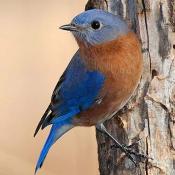
A small thrush. Eastern bluebirds are very social birds. At times, they gather in flocks of a hundred or more. Bluebirds are generally monogamous, staying together throughout the breeding season, and may breed together for more than one season. However, some birds may switch mates during a breeding season to raise a second brood. A bluebird can spot caterpillars and insects in tall grass at the remarkable distance of over 50 yards. State bird of Missouri and New York.
State Bird of Montana: Western Meadowlark

The western meadowlark is a member of the blackbird family. A male usually has two mates at the same time. The females do all the incubation and brooding, and most of the feeding of the young.
The male meadow lark uses visual display behaviors to attract a mate. When he finds a female that he wants to mate with, he points his bill in the air, puffs out his yellow throat and flaps his wings above his head. If that doesn’t get the female’s attention, he hops up and down. The western meadowlark builds its nest on the ground. The female finds a depression in the ground and shapes it by digging in the dirt with her bill. She lines the depression with soft grass and makes a roof by pulling grass and plants over the depression. She then weaves in grass to make a waterproof dome, leaving enough space for an opening. The female lays between three and seven eggs. It takes about 12 days for the eggs to hatch. The meadowlark usually has two broods a year. The male protects the nest by noisily chasing intruders away.
A male’s home range is usually about six or seven acres. If another male invades his territory, he may get into a fight with the intruder. Fighting meadowlarks lock their feet together and peck at each other with their beaks. State bird of Kansas, Oregon, Nebraska, Wyoming, North Dakota, and Montana
State Bird of Nebraska: Western Meadowlark

The western meadowlark is a member of the blackbird family. A male usually has two mates at the same time. The females do all the incubation and brooding, and most of the feeding of the young.
The male meadow lark uses visual display behaviors to attract a mate. When he finds a female that he wants to mate with, he points his bill in the air, puffs out his yellow throat and flaps his wings above his head. If that doesn’t get the female’s attention, he hops up and down. The western meadowlark builds its nest on the ground. The female finds a depression in the ground and shapes it by digging in the dirt with her bill. She lines the depression with soft grass and makes a roof by pulling grass and plants over the depression. She then weaves in grass to make a waterproof dome, leaving enough space for an opening. The female lays between three and seven eggs. It takes about 12 days for the eggs to hatch. The meadowlark usually has two broods a year. The male protects the nest by noisily chasing intruders away.
A male’s home range is usually about six or seven acres. If another male invades his territory, he may get into a fight with the intruder. Fighting meadowlarks lock their feet together and peck at each other with their beaks. State bird of Kansas, Oregon, Nebraska, Wyoming, North Dakota, and Montana
State bird of Nevada: Mountain Bluebird

The different species of bluebirds are not very friendly with each other and even try to exclude the other species from their territories. This is especially true between Mountain Bluebirds and Western Bluebirds since they compete for the same nesting sites. Only the female bluebird builds the nest. The male sometimes acts as if he is helping, but he either brings no nest material or he drops it on the way. Many Native Americans in the southwest see the mountain bluebird as a sacred symbol because of its azure-colored feathers. The Navajo regard it as the herald of the rising sun, the image of a god. State bird of Idaho and Nevada.
State bird of New Hampshire: Purple Finch
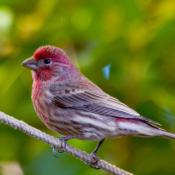
The Purple Finch is a medium-sized finch, having a length of 5-6 inches and weighing a little over half an ounce to an ounce. A group of finches has many collective nouns, including a “charm”, “company”, and “trembling” of finches.
The male Purple Finch has more of a raspberry coloring than purple on its upper body while its underbelly is white.
The female Purple Finch, far less colorful than the male, has brown and white stripes throughout its body. The female’s appearance is very suited for the camouflaging needed in sitting on a nest of eggs.
These birds prefer to be solitary or stay in pairs during the nesting season, but they can be gregarious in the winter and will gather in larger flocks, often mixing with other finches or pine siskins.
State Bird of New Jersey: Willow Goldfinch or American Goldfinch

These are active and acrobatic little finches that cling to weeds and seed socks, and sometimes mill about in large numbers at feeders or on the ground beneath them. Goldfinches fly with a bouncy, undulating pattern and often call in flight, drawing attention to themselves. The American goldfinch is gregarious during the non-breeding season, when it is often found in large flocks, usually with other finches. The social hierarchy, measured by how many aggressive encounters are won by each individual, tends towards the male being dominant in the non-breeding season. During the breeding season, this finch lives in loose colonies. While the nest is being constructed, the male will act aggressively toward other males who intrude into his territory, driving them away, and the female reacts in the same way toward other females. This aggressiveness subsides once the eggs have been laid. State bird of Washington, Iowa, and New Jersey.
State Bird of New Mexico: Roadrunner
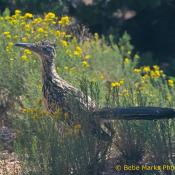
Roadrunners leave behind very distinct “X” track marks appearing as if they are traveling in both directions. The can run up to 20 miles per hour. Because of its quickness, the roadrunner is one of the few animals that preys upon rattlesnakes; it is also the only real predator of tarantula hawk wasps. Breeding pairs are monogamous and mate for life. Both sexes incubate the nest (with males incubating the nest at night) and feed the hatchlings.
State Bird of New York: Eastern Bluebird

A small thrush. Eastern bluebirds are very social birds. At times, they gather in flocks of a hundred or more. Bluebirds are generally monogamous, staying together throughout the breeding season, and may breed together for more than one season. However, some birds may switch mates during a breeding season to raise a second brood. A bluebird can spot caterpillars and insects in tall grass at the remarkable distance of over 50 yards. State bird of Missouri and New York.
State bird of North Carolina: Cardinal

Unlike many other songbirds in North America, both the male and female cardinals can sing. Usually, only a male songbird is capable of singing. When a female cardinal sings from the nest, it usually means she’s telling the male she needs more food. Cardinals mate for life. A group of cardinals has many collective nouns, including a “college”, “conclave”, “deck”, “radiance”, and “Vatican” of cardinals.
The cardinal is the mascot of prominent sports teams and schools, including the St. Louis Cardinals (baseball) and Arizona Cardinals (football); it is the state bird of seven states, more than any other bird: Illinois, Indiana, Kentucky, North Carolina, Ohio, Virginia, West Virginia
State Bird of North Dakota: Western Meadowlark

The western meadowlark is a member of the blackbird family. A male usually has two mates at the same time. The females do all the incubation and brooding, and most of the feeding of the young.
The male meadow lark uses visual display behaviors to attract a mate. When he finds a female that he wants to mate with, he points his bill in the air, puffs out his yellow throat and flaps his wings above his head. If that doesn’t get the female’s attention, he hops up and down. The western meadowlark builds its nest on the ground. The female finds a depression in the ground and shapes it by digging in the dirt with her bill. She lines the depression with soft grass and makes a roof by pulling grass and plants over the depression. She then weaves in grass to make a waterproof dome, leaving enough space for an opening. The female lays between three and seven eggs. It takes about 12 days for the eggs to hatch. The meadowlark usually has two broods a year. The male protects the nest by noisily chasing intruders away.
A male’s home range is usually about six or seven acres. If another male invades his territory, he may get into a fight with the intruder. Fighting meadowlarks lock their feet together and peck at each other with their beaks. State bird of Kansas, Oregon, Nebraska, Wyoming, North Dakota, and Montana
State bird of Ohio: Cardinal

Unlike many other songbirds in North America, both the male and female cardinals can sing. Usually, only a male songbird is capable of singing. When a female cardinal sings from the nest, it usually means she’s telling the male she needs more food. Cardinals mate for life. A group of cardinals has many collective nouns, including a “college”, “conclave”, “deck”, “radiance”, and “Vatican” of cardinals.
The cardinal is the mascot of prominent sports teams and schools, including the St. Louis Cardinals (baseball) and Arizona Cardinals (football); it is the state bird of seven states, more than any other bird: Illinois, Indiana, Kentucky, North Carolina, Ohio, Virginia, West Virginia
State bird of Oklahoma: Scissor-Tailed Flycatcher
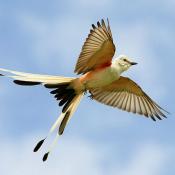
There is almost no mistaking the scissor-tailed flycatcher. The male’s nine-inch-long tail and the female’s slightly shorter one proclaims their identity whether seen in good light or in silhouette, flying or perched. Except for the fork-tailed flycatcher of the American tropics (an extremely rare vagrant north of the Mexican border), no other North American bird has such a long, narrow tail compared with its body size. Pale gray is the scissortail’s predominant color, approaching white on the face and breast. The wings are blackish, the tail black and white. Scarlet “armpits” are mostly concealed while the bird is perched, and a scarlet crown patch is almost always hidden. The flanks and belly are flushed salmon pink, which can vary in brightness from individual to individual.
In spring the male performs an incredible courtship flight. Climbing 100 feet up, he dives, summersaulting and showing off his tail, then tumbles back to a perch. This never fails to impress the girls.
State Bird of Oregon: Western Meadowlark

The western meadowlark is a member of the blackbird family. A male usually has two mates at the same time. The females do all the incubation and brooding, and most of the feeding of the young.
The male meadow lark uses visual display behaviors to attract a mate. When he finds a female that he wants to mate with, he points his bill in the air, puffs out his yellow throat and flaps his wings above his head. If that doesn’t get the female’s attention, he hops up and down. The western meadowlark builds its nest on the ground. The female finds a depression in the ground and shapes it by digging in the dirt with her bill. She lines the depression with soft grass and makes a roof by pulling grass and plants over the depression. She then weaves in grass to make a waterproof dome, leaving enough space for an opening. The female lays between three and seven eggs. It takes about 12 days for the eggs to hatch. The meadowlark usually has two broods a year. The male protects the nest by noisily chasing intruders away.
A male’s home range is usually about six or seven acres. If another male invades his territory, he may get into a fight with the intruder. Fighting meadowlarks lock their feet together and peck at each other with their beaks. State bird of Kansas, Oregon, Nebraska, Wyoming, North Dakota, and Montana
State bird of Pennsylvania: Ruffed Grouse
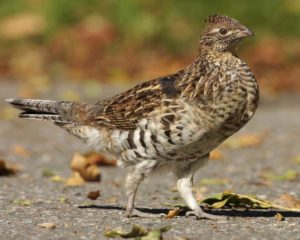
Often incorrectly referred to as a “partridge”, pheasant, or prairie chicken. Other nicknames for ruffed grouse include drummer or thunder-chicken. The ruffed grouse differs from other grouse species in its courtship display. Unlike other grouse species, the ruffed grouse relies entirely on a non-vocal acoustic display, known as drumming. The drumming itself is a rapid, wing-beating display that creates a low frequency sound, starting slow and speeding up (thump … thump … thump..thump-thump-thump-thump).
State bird of Rhode Island: Rhode Island Red
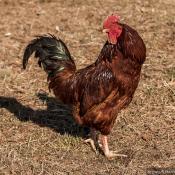
The Rhode Island Red was originally bred in the town of Little Compton, Rhode Island. One of the foundation sires of the breed was a black-breasted red Malay cock – it was common for New England sailors to bring exotic fowl back from ocean voyages, to improve the local flocks. Early flocks often had both single and rose combed individuals. It was from the Malay that the Rhode Island Red got its deep color, strong constitution, and relatively hard feathers.
State bird of South Carolina: Carolina Wren
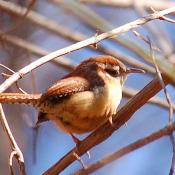
The birds are generally inconspicuous, avoiding the open for extended periods of time. When out in the open, they investigate their surroundings and are rarely stationary. After finding a mate, pairs maintain a territory and stay together for several years. Both sexes give out alarm calls, but only males sing to advertise territory.
In 2000, the Carolina wren was featured on the back of the South Carolina edition of the 50 State Quarters.
State bird of South Dakota: Ring-Neck Pheasant
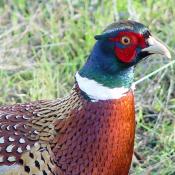
The ring-necked pheasant is the state bird of South Dakota, one of only three U.S. state birds that is not a species native to the United States.
Ring-necked Pheasants are able to stay on a roost for several days without eating if the weather is very bad.
Breeding males will keep other males away from a small group of females during the breeding season. This practice is known as “harem-defense polygyny.”
A group of pheasants has many collective nouns, including a “bouquet”, “brace”, “plume”, “plump”, and “trip” of pheasants.
State Bird of Tennessee: Mockingbird

The mockingbird can imitate many sounds, including the chirps of some 35 different bird species. And the chatty flier can learn over 200 different songs in its lifetime. Northern mockingbirds are very smart animals. They are able to identify humans, especially those that tried to destroy their nests. Northern mockingbirds mate for a lifetime. Male and female build nest together and produce 2 to 4 broods per season. State bird of Arkansas, Florida, Mississippi, Tennessee, Texas
State Bird of Texas: Mockingbird

The mockingbird can imitate many sounds, including the chirps of some 35 different bird species. And the chatty flier can learn over 200 different songs in its lifetime. Northern mockingbirds are very smart animals. They are able to identify humans, especially those that tried to destroy their nests. Northern mockingbirds mate for a lifetime. Male and female build nest together and produce 2 to 4 broods per season. State bird of Arkansas, Florida, Mississippi, Tennessee, Texas
State Bird of Utah: Seagull
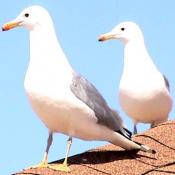
Seagulls learn, remember and even pass on behaviours, such as stamping their feet in a group to imitate rainfall and trick earthworms in to coming to the surface.
Seagulls can drink both fresh and salt water. Most animals are unable to do this, but seagulls have a special pair of glands right above their eyes which is specifically designed to flush the salt from their systems through openings in the bill.
Many seagulls have learned to conserve energy by hovering over bridges in order to absorb raising heat from paved roadways.
Seagulls are fondly remembered in Utah for helping Mormon settlers deal with a plague of crickets. The seagull is now the state bird of Utah and a monument in Salt Lake City commemorates the event, known as the ‘Miracle of the Gulls’.
State Bird of Vermont: Hermit Thrush
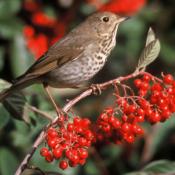
Hermit thrush is a songbird that belongs to the family of thrushes. These birds are rather secretive and stay out of sight most of the time. Hermit thrush is best known by beautiful, flute-like songs that it produces. Song starts with long whistle that subsequently changes into series of musical phrases of different pitches. Unlike the songs of other birds, songs of hermit thrush have harmony. At one time it was nicknamed American nightingale.
State bird of Virginia: Cardinal

Unlike many other songbirds in North America, both the male and female cardinals can sing. Usually, only a male songbird is capable of singing. When a female cardinal sings from the nest, it usually means she’s telling the male she needs more food. Cardinals mate for life. A group of cardinals has many collective nouns, including a “college”, “conclave”, “deck”, “radiance”, and “Vatican” of cardinals.
The cardinal is the mascot of prominent sports teams and schools, including the St. Louis Cardinals (baseball) and Arizona Cardinals (football); it is the state bird of seven states, more than any other bird: Illinois, Indiana, Kentucky, North Carolina, Ohio, Virginia, West Virginia
State Bird of Washington: Willow Goldfinch or American Goldfinch

These are active and acrobatic little finches that cling to weeds and seed socks, and sometimes mill about in large numbers at feeders or on the ground beneath them. Goldfinches fly with a bouncy, undulating pattern and often call in flight, drawing attention to themselves. The American goldfinch is gregarious during the non-breeding season, when it is often found in large flocks, usually with other finches. The social hierarchy, measured by how many aggressive encounters are won by each individual, tends towards the male being dominant in the non-breeding season. During the breeding season, this finch lives in loose colonies. While the nest is being constructed, the male will act aggressively toward other males who intrude into his territory, driving them away, and the female reacts in the same way toward other females. This aggressiveness subsides once the eggs have been laid. State bird of Washington, Iowa, and New Jersey.
State bird of West Virginia: Cardinal

Unlike many other songbirds in North America, both the male and female cardinals can sing. Usually, only a male songbird is capable of singing. When a female cardinal sings from the nest, it usually means she’s telling the male she needs more food. Cardinals mate for life. A group of cardinals has many collective nouns, including a “college”, “conclave”, “deck”, “radiance”, and “Vatican” of cardinals.
The cardinal is the mascot of prominent sports teams and schools, including the St. Louis Cardinals (baseball) and Arizona Cardinals (football); it is the state bird of seven states, more than any other bird: Illinois, Indiana, Kentucky, North Carolina, Ohio, Virginia, West Virginia
State bird of Wisconsin: Robin

The robin is considered a symbol of spring, often the first migratory bird to return north. There is a Quebec superstition that whoever sees the first robin of spring will have good luck. American robins have exceptionally keen eyesight that allows them to see the tiny disturbances in the soil that indicate where worms are moving. This is how robins find worms, though they also use their senses of hearing and touch as part of their hunting as well. State bird of Connecticut, Michigan, Wisconsin
State Bird of Wyoming: Western Meadowlark

The western meadowlark is a member of the blackbird family. A male usually has two mates at the same time. The females do all the incubation and brooding, and most of the feeding of the young.
The male meadow lark uses visual display behaviors to attract a mate. When he finds a female that he wants to mate with, he points his bill in the air, puffs out his yellow throat and flaps his wings above his head. If that doesn’t get the female’s attention, he hops up and down. The western meadowlark builds its nest on the ground. The female finds a depression in the ground and shapes it by digging in the dirt with her bill. She lines the depression with soft grass and makes a roof by pulling grass and plants over the depression. She then weaves in grass to make a waterproof dome, leaving enough space for an opening. The female lays between three and seven eggs. It takes about 12 days for the eggs to hatch. The meadowlark usually has two broods a year. The male protects the nest by noisily chasing intruders away.
A male’s home range is usually about six or seven acres. If another male invades his territory, he may get into a fight with the intruder. Fighting meadowlarks lock their feet together and peck at each other with their beaks. State bird of Kansas, Oregon, Nebraska, Wyoming, North Dakota, and Montana
Pictures downloaded from State Symbols USA.org
Images on State Symbols USA are either original, public domain, published with the permission of the copyright owner, or published under terms of a specific creative commons license.
